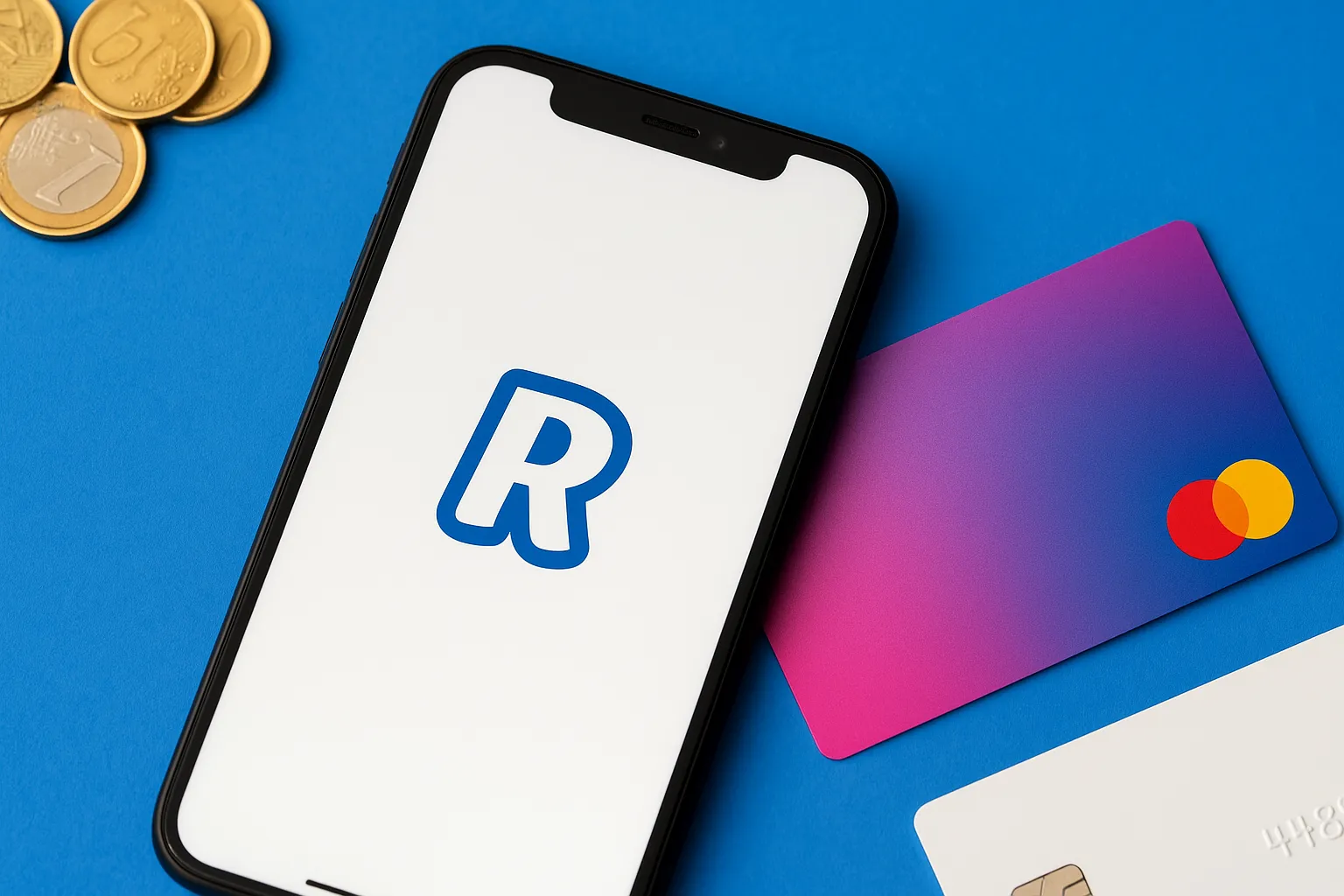Business Model of Revolut has redefined the way millions of people handle their finances. Launched in 2015, this London-based fintech company started as a simple prepaid card offering currency exchange at interbank rates. Today, Revolut has evolved into a full-fledged digital banking alternative with over 40 million customers worldwide.
Understanding Business Model of Revolut business model is essential for any entrepreneur aiming to build a modern, profitable finance app. From its freemium strategy to innovative revenue streams like crypto trading and premium subscriptions, Revolut shows how a disruptive financial platform can grow rapidly while diversifying income sources.
What is Revolut & How It Works
Revolut is a neobank that solves the hassle of traditional banking with a mobile-first experience. It offers everything from global currency exchange to crypto trading, all through a sleek, user-friendly app. Users can open an account in minutes without visiting a branch or filling out paperwork. Its all-in-one platform empowers people to spend, save, and invest seamlessly from their smartphones.
Problem It Solves:
- Expensive currency conversion fees
- Complex money transfers across borders
- Limited access to modern financial tools
- Clunky user experiences with legacy banks
Who Uses Revolut?
- Frequent travelers who need cost-effective currency exchange
- Digital nomads managing money in multiple countries
- Millennials and Gen Z users seeking modern banking alternatives
- Small businesses and freelancers who want streamlined accounts
How Revolut work Operates:
- Users download the app and verify their identity
- They can open an account instantly without paperwork
- Revolut issues a physical or virtual card for spending
- The app enables money transfers, budgeting tools, trading, and more
- Revenue comes from premium plans, interchange fees, and value-added services
By combining banking, investing, and spending in one platform, Revolut has become a single financial hub for a new generation of customers.
Read more : What is a Revolut App and How Does It Work?
Target Audience For Financial Services
Revolut has built its business model around serving digitally savvy customers who expect speed, transparency, and control.
Frequent Travelers
People who regularly cross borders and want to avoid high foreign exchange fees on their trips.Revolut’s real-time currency exchange and fee-free spending make it the perfect travel companion.
Millennials & Gen Z Users
Younger generations prefer managing all finances through a mobile app instead of visiting physical branches.They value instant notifications, sleek design, and the ability to control money anytime, anywhere.
Freelancers & Digital Nomads
Independent workers who invoice clients internationally and need flexible, multi-currency accounts. Revolut helps them receive payments faster and avoid expensive bank fees.
Small Business Owners
SMEs are looking for affordable business accounts with integrated spending and budgeting tools. Revolut Business offers streamlined expense management and easy payment solutions tailored to their needs.
Crypto Enthusiasts
Users interested in buying and holding cryptocurrencies directly within the app. Revolut makes it easy to trade digital assets alongside traditional currencies in a single dashboard.
Everyday Consumers
People who want better budgeting, instant transfers, and attractive cashback rewards on daily purchases. These features help Revolut become their primary financial app instead of just a secondary option.
Read More : How to Hire the Best Revolut Clone Developer
Features that Support the Business Model
Revolut has packed its app with features that not only delight users but also drive sustainable income. Here are the key capabilities powering its business model:
Multi-Currency Accounts
Users can hold and exchange over 30 currencies at interbank rates, avoiding the high markups that traditional banks charge. This makes Revolut especially appealing to travelers and remote workers who deal with multiple currencies regularly.
Premium & Metal Plans
Subscription tiers like Premium and Metal offer perks such as higher ATM withdrawal limits, overseas medical insurance, and exclusive card designs. These plans create recurring revenue streams while also boosting customer loyalty.
Instant Money Transfers
Revolut makes it easy to send money instantly to friends, family, or other users anywhere in the world. Free peer-to-peer transfers and low-cost international payments keep customers engaged and encourage them to use Revolut as their primary banking solution.
Crypto & Stock Trading
The app allows users to buy, hold, and sell cryptocurrencies and fractional shares directly from their account. These trading features generate commissions and appeal to users looking for an all-in-one financial platform.
Merchant Acquiring & Business Accounts
Revolut Business offers payment acceptance, invoicing, and expense management tools tailored to small and medium-sized enterprises. These business accounts create new revenue streams through subscriptions
Budgeting & Analytics
Built-in budgeting tools automatically categorize spending, set saving goals, and provide smart financial insights. These features improve customer satisfaction, help users feel in control of their money, and ultimately increase long-term retention.
Card Rewards & Cashback
Revolut offers cashback and rewards programs that incentivize more frequent card usage. This not only drives interchange fee revenue but also strengthens the habit of spending through Revolut cards instead of competitors.
Together, these features create a sticky ecosystem where customers find everything they need—and are willing to pay for premium experiences.
Read More : Revolut App Features List: What Makes It a Fintech Powerhouse?
Revenue Streams of Revolut
Revolut uses a mix of subscription, transactional, and partnership income to grow revenue. Below is a clear table summarizing each stream:
| Revenue Stream | How It Works |
| Premium Subscriptions | Monthly fees for Plus, Premium, and Metal plans with added benefits |
| Interchange Fees | A percentage of each card transaction paid by merchants |
| Currency Exchange Fees | Small markup on currency conversion beyond free limits |
| Crypto & Stock Trading | Commission fees on buying and selling assets |
| Business Accounts | Subscription and transaction fees for SMEs |
| Interest on Deposits | Earnings from lending customer deposits to partner banks |
| Insurance Products | Commissions from offering travel and device insurance |
Details:
- Premium Subscriptions:
- Plans like Premium (£7.99/month) and Metal (£13.99/month) generate recurring income.
- Plans like Premium (£7.99/month) and Metal (£13.99/month) generate recurring income.
- Interchange Fees:
- Every time users pay with a Revolut card, Revolut earns a small fee from the merchant’s payment processor.
- Every time users pay with a Revolut card, Revolut earns a small fee from the merchant’s payment processor.
- Currency Exchange Fees:
- While most users get free currency exchange up to a limit, larger volumes incur a small fee.
- While most users get free currency exchange up to a limit, larger volumes incur a small fee.
- Crypto & Stock Trading:
- Revolut charges commissions on trades, creating an additional revenue stream.
- Revolut charges commissions on trades, creating an additional revenue stream.
- Business Accounts:
- SMEs pay monthly fees and transaction costs for Revolut Business services.
- SMEs pay monthly fees and transaction costs for Revolut Business services.
- Interest & Insurance:
- Earnings come from both customer deposits and cross-sold insurance products.
- Earnings come from both customer deposits and cross-sold insurance products.
Together, these diversified streams reduce reliance on any single income source and position Revolut for scalable growth.
Cost Structure Behind Revolut Operations
Running a fintech platform at Revolut’s scale involves significant operating expenses. Here are the main cost drivers:
Customer Support & Operations
24/7 in-app support teams handle thousands of daily queries, ensuring smooth customer experiences.Compliance staff manage fraud prevention, account verification, and regulatory reporting.
Technology Infrastructure
Cloud hosting and cybersecurity systems keep the platform fast and secure.
Continuous app development and integration with global payment networks are essential investments.
Licensing & Compliance
Revolut must maintain licenses in every market where it operates, which adds complexity.
This includes costs for audits, anti-money laundering (AML) measures, and local regulatory approvals.
Marketing & Customer Acquisition
The company invests heavily in advertising campaigns to attract new users.
Referral bonuses and promotions further accelerate growth but add to expenses.
Card Issuance & Fulfillment
Producing and shipping millions of physical cards, especially premium Metal cards, is costly.
This includes manufacturing, logistics, and packaging for a smooth customer experience.
Insurance & Partnerships
Revolut shares revenue with insurance partners that provide travel and device coverage.
Partnership agreements also involve commissions and co-marketing investments.
Research & Product Development
The team continuously builds new features, like lending products and crypto services.
Investment in analytics and AI capabilities keeps Revolut ahead of competitors.
Despite high costs, Revolut’s business model scales efficiently as the user base grows, spreading fixed expenses over millions of customers.
Read more : Exploring the Revenue Model Behind Revolut
2024–2025 Innovations or Updates
Revolut has continued to evolve its platform with fresh features, pricing tweaks, and expansion strategies. Here are some notable updates shaping its business model today:
Launch of Revolut Ultra Plan
A new top-tier subscription offering higher cashback, airport lounge access, and exclusive concierge services.This plan targets high-value customers willing to pay more for premium experiences and added convenience.
Expansion into Lending
Revolut has rolled out personal loans and credit lines in more European markets and Australia.This adds interest income as a major new revenue stream and deepens customer engagement.
Enhanced Crypto Offering
The app now supports more tokens and staking options for users interested in digital assets.
These features help capture growing demand for crypto trading and generate additional commissions.
Business Account Upgrades
New invoicing tools and bulk payment features have been launched to attract SMEs.
These upgrades strengthen Revolut’s position in the business banking market and unlock more B2B revenue.
AI-Powered Financial Assistant
A smart assistant provides predictive budgeting, spending insights, and custom recommendations.This improves the user experience and creates more opportunities for upselling premium services.
Fee Adjustments
Revolut has updated foreign exchange limits and made minor increases to some premium plan fees.These changes help maintain healthy margins while funding continued platform development.
Sustainable Finance Initiatives
The company has introduced green investments and carbon offsetting options for customers.This aligns with shifting consumer values and strengthens Revolut’s brand as a responsible fintech leader.
These moves help Revolut stay competitive while diversifying both revenue and engagement opportunities.
Takeaways for Startup Founders
Revolut’s journey offers valuable lessons if you’re planning to build a fintech app:
Diversify Revenue Early
Don’t rely only on interchange fees, as they can be unpredictable and volume-dependent.
Subscriptions, trading, and premium services create more stable, recurring income streams.
Focus on User Experience
Simple onboarding flows make it easy for users to get started without friction or confusion.
Transparent pricing and clear value propositions help build trust and long-term retention.
Build an Ecosystem, Not Just a Product
Revolut keeps users engaged with a bundle of services under one roof.
Banking, investing, insurance, and budgeting tools all reinforce loyalty and daily usage.
Leverage Data for Personalization
Smart analytics and AI recommendations turn raw data into valuable insights.
These features drive higher engagement, better cross-sells, and more upselling opportunities.
Stay Compliant & Agile
Regulatory compliance is critical in fintech and can’t be an afterthought.
Plan for licensing, KYC processes, and anti-fraud measures right from the start.
Read more : Pre-launch vs Post-launch Marketing for Revolut Clone Startups
Why Build With Miracuves?
Miracuves makes launching a fintech platform faster, safer, and more cost-effective.
With our Revolut app solution, you can skip years of development headaches.
- Get a ready-made core banking app tailored to your brand.
You’ll save time while offering customers an enterprise-grade experience. - Integrate crypto, payments, and subscriptions without reinventing the wheel.
Our modular approach helps you expand as your business grows. - Rely on proven security and compliance frameworks.
You’ll meet regulatory requirements confidently from day one. - Focus on growth while we handle technology and updates.
Let your team zero in on marketing and scaling instead of infrastructure.
Conclusion :
Revolut has transformed from a simple currency exchange tool into one of the world’s most innovative fintech ecosystems. Its business model—built on subscriptions, trading, and a unified customer experience—shows exactly how modern financial apps can scale rapidly while staying profitable.
If you’re an entrepreneur ready to create the next big neobank or fintech platform, you don’t have to start from scratch. Miracuves can help you launch a feature-rich app inspired by Revolut’s proven strategies, complete with robust security, compliance, and world-class design.
Ready to build your own Revolut-style app?
Get in touch with Miracuves to explore how our Revolut can bring your vision to life—faster, smarter, and more affordably.
FAQs :
1. How does Revolut make most of its money?
Revolut’s biggest revenue sources are premium subscription plans (like Premium and Metal), interchange fees from card transactions, and trading commissions on crypto and stocks. Over time, lending and business accounts have become more important contributors to revenue.
2. Is Revolut profitable?
Revolut has reported periods of profitability, especially as its user base and premium subscriptions have grown. However, it continues to reinvest heavily in product development and expansion, which can impact short-term profits.
3. Can startups replicate Revolut’s business model?
Yes—though it requires careful planning around licensing, compliance, and technology. With the right partner like Miracuves and a clear monetization strategy, you can build a similar multi-service fintech app more efficiently.
4. What are the main challenges in launching a Revolut-style app?
The biggest challenges include obtaining regulatory approvals, ensuring airtight security, managing cross-border transactions, and creating a frictionless user experience. Working with an experienced development team significantly reduces these risks.
5. How long does it take to build a Revolut-like platform?
If you develop everything from scratch, it can take 12–24 months. With a ready-made Revolut from Miracuves, you can launch much faster—often in just a few 3-9 days, depending on customization.
Related Articles :








